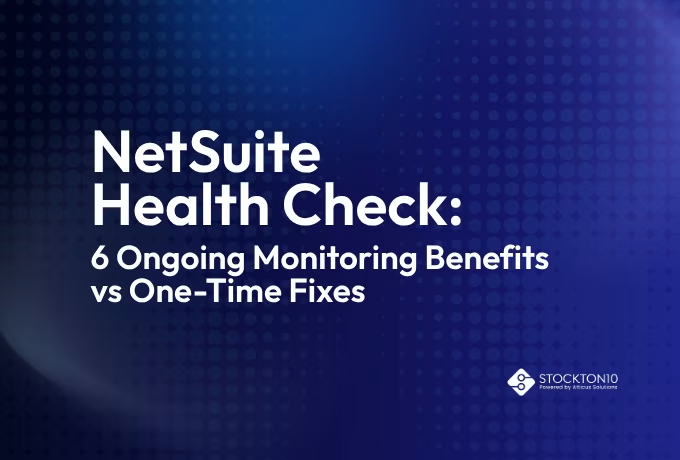Most NetSuite environments don’t break dramatically. They just start feeling heavier.
Scripts that used to run in seconds take minutes.
Approvals stall behind invisible logic.
Integrations stop syncing quietly until finance notices a mismatch weeks later.
That’s how most companies learn that go-live was only the first phase.
Every NetSuite build, no matter how clean the launch, needs maintenance that’s intentional, not reactive. Because under the surface, every script, workflow, and integration needs care to keep pace with your business.
In this article, we’ll unpack what real NetSuite maintenance looks like beyond vague promises of “support.”
You’ll see the four official types defined by Oracle itself, plus two service models that determine how well your environment actually scales once the implementation dust settles.
What Maintenance Really Means for NetSuite Development
Maintenance in NetSuite is the quiet work that keeps your system useful.
It’s not about fixing problems after the fact. It’s about keeping custom scripts, workflows, and integrations working smoothly as your business grows and NetSuite evolves.
Cloud ERP is constantly changing.
Every release can affect your logic, APIs, or SuiteScripts. Add new subsidiaries, currencies, or compliance rules, and your custom build needs to keep up.
That’s why Oracle defines four primary maintenance types. Each one addresses a different kind of system need.
4 Types of NetSuite Maintenance You Should Be Using
There are four core types of ERP maintenance that apply directly to NetSuite: corrective, preventive, adaptive, and perfective.
- Corrective maintenance keeps it steady.
- Preventive routines keep it resilient.
- Adaptive changes keep it compliant.
- Perfective improvements keep it ahead.
Together, they form the backbone of a healthy, future-proof instance. Because a healthy NetSuite system doesn’t demand attention.
It just works.
1. Corrective maintenance: Fixing what slows you down
Every NetSuite system picks up a few quirks over time.
A script that used to run fine suddenly errors out. A workflow stalls because an approver left. An integration stops syncing after an update.
That’s where corrective maintenance comes in: fixing what’s broken before it snowballs into downtime or bad data.
Here’s what it looks like in real life:
A tech client set up Avalara for multi-state tax filing. When their in-house developer resigned, the whole thing fell apart. Invoices stopped posting across ten states.
Stockton10 stepped in, rebuilt the token process, and unified their tax configuration. Within days, invoicing was stable again.
Why it matters:
- Keeps data accurate and transactions flowing
- Prevents outages from compounding
- Restores trust in your system and team
Corrective maintenance isn’t glamorous. But it’s the reason your finance team sleeps well at night.
2. Preventive maintenance: Staying ahead of updates
NetSuite releases updates twice a year. If you’re not testing before rollout, you’re gambling with uptime.
Preventive maintenance means you’re ready before things break. It’s the discipline of checking what still works, cleaning what doesn’t, and predicting what might.
It usually includes:
- Reviewing custom scripts in the release preview
- Cleaning up old workflows and saved searches
- Testing integrations before major version updates
- Running regular health checks
One retail client learned this the hard way.
Their NetSuite Planning and Budgeting setup crashed under undocumented code. Stockton10 restructured the connection, built testing checkpoints for every release, and documented everything for their purchasing team.
The result? 30-50% less manual work, zero post-update errors, and a calmer operations floor.
Preventive work doesn’t make noise. But that’s the point. Your system runs quietly because you caught issues early.
3. Adaptive maintenance: Aligning with change
Your business doesn’t stay still. Neither should your ERP.
Adaptive maintenance keeps NetSuite aligned with what’s new, whether that’s a law, a product line, or a market.
You’ll need it when:
- You expand to new regions or subsidiaries
- Regulations shift and reporting rules change
- Third-party integrations update their APIs
A telecom client faced this when the Philippines’ EOPT law redefined VAT recognition. Their old scripts used cash-based logic.
Stockton10 rebuilt them for invoice-based recognition, updated templates, and protected historical data. Compliance stayed intact without pausing operations.
Adaptive maintenance is what keeps you compliant while everyone else scrambles to catch up.
4. Perfective maintenance: Pushing performance forward
Once your system runs smoothly, perfective maintenance helps it run smarter.
It’s about fine-tuning; finding what still takes time and asking, “Can this be faster?”
That might mean:
- Automating manual steps
- Cleaning redundant processes
- Improving dashboard layouts
- Optimizing high-volume scripts
A healthcare client’s finance team used to spend hours manually creating revenue recognition entries. Stockton10 built a Suitelet that automated everything and redesigned their invoice templates.
Manual entries dropped from hundreds to zero.
Perfective maintenance is where growth happens. It’s what separates a working system from one that’s actively driving performance.
Two Service Models That Keep Maintenance Sustainable
Knowing the four maintenance types is one thing.
Deciding who manages them day to day is where most teams get stuck.
There are two proven ways to organize ongoing NetSuite development maintenance: a managed development partner or a hybrid internal and external model.
Model A: Managed development partner
Best fit: Companies that treat NetSuite as a long-term operational core rather than a one-time setup.
This setup gives you a dedicated external team that knows your NetSuite inside out. They handle everything: updates, bug fixes, enhancements, version testing, usually under a monthly retainer.
It’s not just outsourcing. It’s consistency.
You’ll want this model if:
- You don’t have internal developers or admins
- Your environment runs on multiple integrations or subsidiaries
- You want predictable monthly costs instead of ad-hoc projects
Example:
A real estate client needed an automated commission process but had no in-house developer. Stockton10 built the custom records and scripts, deployed them, and stayed on retainer to maintain updates.
The result? No stalled approvals, no turnover delays, and one stable source of truth for finance.
A managed partner becomes part of your rhythm; the team that knows your instance’s quirks better than anyone else.
Model B: Hybrid internal and external team
Best fit: Companies that want to scale their technical capabilities without over-expanding internal teams.
Some companies already have NetSuite admins or tech-adept finance staff who handle smaller fixes. They just need outside support for heavier lifts, e.g., integrations, version upgrades, or deep performance tuning.
That’s where the hybrid model works best.
How it works:
- Your internal team manages everyday updates and troubleshooting
- Your partner handles complex or high-stakes work
- Both collaborate so improvements never stall
Example:
A BPO client needed to overhaul its approval workflows but lacked a sandbox for testing. Stockton10 used the release preview environment to simulate changes, saving the company $1,000 in sandbox costs.
The client’s admins handled user testing while Stockton10 rebuilt the logic. The new workflow reduced turnaround time by 80% and approvals no longer sat idle.
This setup keeps knowledge in-house while giving you a safety net for big projects. It’s flexibility without all the issues
How to compare and choose your maintenance setup
The right maintenance model depends on your size, complexity, and how much control you want to keep internally.
If your setup includes:
- Multiple subsidiaries or global tax requirements
- Custom scripts and third-party integrations
- Frequent version releases or regulatory exposure
A managed partner brings structure and depth.
If your setup is lighter and you already have a capable admin or IT lead, the hybrid model offers a balance of autonomy and expertise.
Your goal isn’t to pick the flashier option. It’s to choose a setup that keeps projects moving even when team members change or budgets tighten.
How to Know Your Current Maintenance Model Needs Work
You’ll usually feel it before you see it.
- Updates create more problems than they solve
- Teams avoid editing workflows because “something might break”
- Scripts run slower, and nobody knows what half of them do
- You’re repeating the same support tickets month after month
When those patterns show up, maintenance has already slipped into survival mode.
What you want instead is a calm, predictable rhythm: review, document, optimize, repeat. It keeps your system aligned with how your business actually runs, not how it looked when you first went live.
7 Best Practices for Sustainable NetSuite Development Maintenance
A good maintenance model needs a process behind it. Here’s what that looks like in practice:
- Keep documentation current: Every script, field, and workflow should have an owner and a purpose. When people move on, the knowledge doesn’t disappear.
- Run quarterly system reviews: Check integrations, saved searches, and automations against real workflows. Remove anything redundant or outdated.
- Test before every release: Use the release preview environment to see how new versions affect your scripts. It’s the simplest way to prevent downtime.
- Audit data and permissions: Old roles, records, and unused scripts slow your system and create risk. Clean them regularly.
- Budget for adaptive work: Regulatory changes, new integrations, and growth milestones always require tweaks. Plan for them early so they never cause panic.
- Measure impact: Track tangible improvements like fewer error tickets, faster report loads, or shorter close cycles. Maintenance should create visible progress.
- Choose transparent partners: The right team leaves every configuration documented so you stay in control of your environment, not dependent on outside knowledge.
Maintenance isn’t expensive. It’s how you protect and expand the value of your ERP investment.
How Stockton10 Supports Long-Term NetSuite Development
At Stockton10, we see NetSuite as a living system: one that needs care, not just setup.
Our development and maintenance services are designed to help companies scale without little to no risk or unwanted surprises.
We handle post-implementation updates, custom scripting, integrations, and version testing so your internal teams can focus on strategy, not system recovery.
Here’s how we work:
- Fast response: Every ticket gets a reply within 30 minutes.
- No expiring hours: You always get the full value of what you’ve paid for.
- Dedicated consultants: The same experts stay with your account long term, learning your workflows and history.
We’ve supported clients across industries from real estate to retail to telecom fixing what others left unfinished and building systems that grow stronger over time.
If your current setup feels slow, scattered, or reactive, it’s time to rethink your maintenance model.
Book a consultation and we’ll help you find the balance between reliability and innovation.














